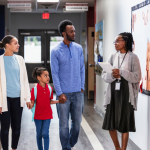Individualized, virtual learning continues to show promise by expanding the possibilities of what, when, how, and where students learn.
The Thomas B. Fordham Institute highlights how these programs provide valuable opportunities in a variety of ways. “Many schools offer a career-focus or engage in some form of personalized learning, for example, while others offer college-readiness programs. Still others are oriented around particular pedagogical perspectives, such as those with constructivist, content-focused, or twenty-first-century-skills offerings. The sector also particularly caters to students who are credit-deficient or who have otherwise had difficulty in traditional schools.”
However, it also comes with its fair share of challenges. Schools must balance providing distinct instruction for each student with state compliance and uniform tracking of academic progress. Each layer of customization adds complexity and increases instructional demands. Addressing the students’ individual needs thoughtfully can help mitigate additional workloads without causing staff burnout or losing sight of student outcomes.
For charter schools offering Independent Study or virtual learning options, it’s especially important to have clear strategies and proven tools in place. Doing so will set your program up for success—not just in the short term, but well into the future.
What Makes an Effective Individualized Learning Program?
An effective individualized learning program offers academic rigor while allowing for flexibility that meets unique student needs. Often, families turn to individualized learning options when traditional educational settings fall short. For example, some students thrive best in a low-distraction environment. Others have medical needs that can best be met through a virtual education program. Some have special interests or talents that can be nurtured through a particular curricular approach or schedule. For these groups, individualized learning programs offer options that would not otherwise be available.
The most successful individualized learning programs will have the following components:
- Clear learning objectives: There are various ways to meet an educational goal. However, the learning objectives need to be measurable and aligned with state standards and student goals.
- Learning style personalization: Personalizing learning styles empowers students to engage with content in ways that align with how they learn best. Honoring these differences can look like varying instruction method, learning environment, and pace of content delivery.
- Flexible structures: Flexibility is one of the biggest benefits of individualized learning programs, especially in virtual and hybrid models. However, too much flexibility without structure can lead to students getting off track. The key is to create clear expectations and consistent support.
- Continuous tracking: Accountability and personalization go hand in hand. Make progress tracking part of the learning experience, and help students see their own growth while grounding your decisions in measurable insights.
The most successful programs provide the right balance of structure and personalized flexibility. When schools maintain alignment, these programs are an excellent way to provide high-quality instruction to students who might otherwise struggle to have their needs met.
Best Practices for Creating and Managing Individualized Learning Programs
Creating and managing individualized learning programs in an Independent Study or virtual setting is best achieved by implementing several best practices.
Start With a Strong Initial Assessment
Early benchmarking of students’ depth of knowledge is a powerful way to understand where students are starting and what they need to grow. This gives educators measurable data that can help shape instruction and set realistic, personalized goals. And it’s worth noting that diagnostics aren’t high-stakes tests. They’re meant to be low-pressure, growth-focused check-ins that inform the learning journey, not define it.
Start with an initial assessment to establish a solid benchmark. The most effective approach includes a variety of assessments delivered at different stages of the learning experience. Methods like learning style inventories, academic pre-tests, progress checks, and interim assessments build a well-rounded picture of each student’s progress and needs. These tools support instructional planning, program evaluation, and transparent communication with families.
The more complete the data set, the more effectively you can support every learner on their individual path to success.
Empower Students and Families in Goal Setting
A well-designed individualized learning plan takes into account the student’s strengths, interests, aspirations, and unique learning needs. Bringing together the student, their family, and their teacher or advisor regularly in collaborative goal-setting meetings ensures everyone is aligned on the student’s objectives and learning plan. These sessions should provide an opportunity for students to reflect on their progress and explore the best path forward—whether that’s preparing for a certification program, exploring a potential career path, or just discovering what kind of learner they are.
With a plan in place, make sure to give students active ownership in how they work toward their goals. Inviting students to co-create parts of the syllabus, help choose readings or materials, or help shape class policies fosters a stronger sense of ownership in their learning. Likewise, offering choices in how they demonstrate their knowledge, be it a written report, video presentation, or creative project, can boost confidence, engagement, and pride in their work.
Choose Adaptable Curricula and Instructional Methods
Designing curricula with flexibility in mind will help ensure your learning program meets a wide range of student needs by offering precise, personalized options without losing structure. There are many ways to build materials with adaptability in mind.
When developing your curriculum plan, the biggest key will always be catering to your program’s specific students and educators. Mixing digital and physical curricula can offer a full suite of learning and practice options for students, but some curricula providers will better fit your teachers’ and students’ needs than others. Consider gathering a review committee to evaluate different providers and build a feedback loop for assessing learning progress.
Technology makes this even easier. Tools designed for personalized instruction like adaptive software, digital portfolios, and interactive assignments can create more access points and enhance engagement for every learner. Educators can also use pre-loaded lesson plans and integrated digital content providers in a unified solution suite to create, assign, and deploy instruction while providing valuable insights for teachers. Additionally, consider offering supplemental links for curious learners who want to dig deeper, or printable versions for students working offline.
Build in Regular Check-Ins and Adjustments
The best educational plan is one that keeps the student engaged. Especially in non-traditional learning environments, tracking engagement consistently helps educators see when a student is leaning in or fading out in their learning. This means looking at things like time-on-task, attendance, the quality of student responses, and even how willing they are to take on academic challenges.
At the same time, educators need to know how to spot the signs when something’s off. Disengagement can show up in different ways—frequent absences, missing assignments, surface-level work, or students going quiet during virtual sessions. These are all signals that a student might be disengaged or struggling to connect with the learning experience.
That’s where frequent touchpoints and layered support systems come in. When students have consistent check-ins and mentors they can turn to—whether it’s a teacher, advisor, or academic coach—it creates a safety net as staff can pinpoint early warning signs and respond with timely interventions. When you check-in with students, try different structures, create a follow-up plan, and observe what works and what doesn’t.
Maintain Compliance Without Creating Administrative Overload
Individualized learning programs, including Independent Study, need to be ready for audits—and that means keeping documentation organized, accurate, and up to date. Compliance resources from organizations like CCIS or the Aurora Institute can be a big help, especially when paired with technology that automates and streamlines the process.
Staying ahead of changing regulations also means actively engaging in professional development, attending webinars on policy updates, connecting with charter school associations, and using tools that enhance compliance throughout your daily workflows and learning plans.
The planning and implementation of an individualized learning program require many components. Thoughtful attention to core values coupled with proactive inclusion of policies and tools built around compliance and educational flexibility sets the program up for ongoing success.
Tools & Resources To Simplify Individualized Learning Program Management
Instructional technologies can make it easier and more integrated to design and implement individualized learning programs.
Purpose-built systems like School Pathways’ PLS give schools a comprehensive solution to support every part of their Independent Study program. With one system, educators can manage Master Agreements digitally, track activity in audit-ready documentation, simplify tier re-engagement, customize lesson plans, and simplify communication across all stakeholders.
Additionally, educators and staff receive expert support every step of the way, so they are never left to navigate implementation alone.
As Michael Brubaker, Director of Operations of Visions in Education, explains, “The professionalism and the support that comes from School Pathways is amazing. They have great products, but you combine that with their ability to accept feedback and their ability to be proficient in their training and working with us to ensure we know how the functionality works and how to make it work in our environment and infrastructure; it is a winning combination.”
Reach Families Where They Are With Individualized Learning
When best practices meet the right edtech tools, individualized learning programs can find success—especially for students who haven’t found their fit in traditional classrooms. Providing these flexible and adaptive educational options reaches families where they are and redefines what equitable education looks like.
With an integrated SIS solution, School Pathways provides user-friendly, reliable tools designed to help individualized learning program leaders streamline Independent Study aspects and increase administrative efficiency. As a result, educators can focus on delivering the best and most engaging instruction that meets their student’s unique needs in any learning environment.
Get in touch to schedule a demo.





